There are only cosmetic updates to the 2017 RM-Z250 in 2017 and we approve of those changes. Suzuki updated the RM-Z250 with increased black and yellow accents to the machine like black wheels, triple clamps, side panels, shock spring, a yellow rear fender, a yellow/black seat cover and of course some updated shroud graphics. We received our fresh yellow scoot recently and wanted to give you a brief overview on what it’s like to ride the Suzuki RM-Z250.
The RM-Z250’s engine has great throttle response and is snappy off the bottom end. The meat of its power is in the bottom to mid range and pulls strong immediately out of corners. The RM-Z250 is very good on low rpm’s and can lug around hard pack tracks and get rear wheel traction better than other current 250F’s. The downside to the RM-Z250’s engine character is that it doesn’t pull very far up on top end. Its powerband is narrow and somewhat difficult to ride. Shifting is very crucial to the Suzuki and it is up to the rider to shift precisely around the track to execute fast lap times. The engine needs more pulling power when the track is tilled deep, especially if there are sizeable jumps. Going to the optional lean coupler will help you get some added mid range and will help clean up the dirty (rich) low end feeling the RM-Z can come with.
The Suzuki’s KYB PSF2 fork is tough to figure out immediately. The stock 34-psi that Suzuki recommends is decent for a 150-pound rider, but when the track gets rough it will get harsh and deflect. We ended going to a stiffer setting (35 psi) and softened the compression three clicks. We played with the high and low speed rebound damping to get a better front end feeling on acceleration, but always came back to a stock setting (15 clicks on high speed and 16 clicks on low speed). The fork’s action is initially a little stiff and it progressively seems to get empty (or soft) at the end of its stroke. Raising the air pressure only hurt the top of the stroke and gave us an increasing harsher feeling through the mid-stroke. The shock squats out of corners and has more performance and comfort (on square edge and braking bumps) than the fork. We ran up to 106mm of sag in the rear and dropped the fork down in the clamps (from 8mm to 4mm). Dropping the fork helped the balance of the RM-Z and didn’t leave us with a stinkbug feeling coming into corners. Doing this also didn’t hurt the Suzuki’s impeccable cornering ability. We don’t know why Suzuki runs the fork up so high in the clamp, but we recommend dropping the fork down immediately.
This chassis was tailored made for tight, rut filled tracks. The RM-Z250 turns the sharpest and lays over the easiest out of all the 250 MX’ers. The frame is also not as rigid as the 2015 version, but still needs some added comfort on rough tracks. When the track was smooth and fresh in the morning the Suzuki’s chassis is like riding on rails. The RM-Z does feels heavy when taking it off the stand, but it doesn’t nearly feel as bad on the track. In the air it is very flickable and can make sudden line changes on the track comfortably. When the track started getting larger holes and bumps the Suzuki can get tough to ride. We feel this frame is geared more towards smoother, jump filled tracks.
The new styling for 2017 is so much better and we feel this is the most attractive looking RM-Z in recent years. The black rims and yellow rear fender make the 250 that much more appealing to the eye. This is still a very fun bike to ride on the track; it just takes patience to get it set up for where you’re riding. The RM-Z250 corners better than any other machine out there and when you think about it, that is where races are won and lost. We are hoping for some added ponies and a better fork for 2018, but with a few aftermarket engine parts and a little massaging of the suspension this could be a serious racing weapon for you 2017.
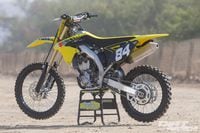
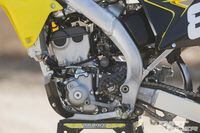
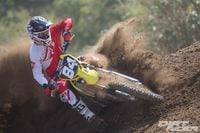
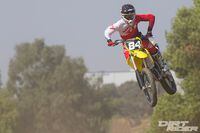
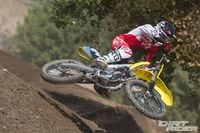
/cloudfront-us-east-1.images.arcpublishing.com/octane/IQNDTQPP4BE3HE5JUWJ36ONAUU.jpg)
/cloudfront-us-east-1.images.arcpublishing.com/octane/Z6YUC3S26FF4TOKFTXZ7I746YY.jpg)
/cloudfront-us-east-1.images.arcpublishing.com/octane/UOWIK3H4BJHP7F4ONETCB7IXDQ.jpg)
/cloudfront-us-east-1.images.arcpublishing.com/octane/PCDJQEHF35A4LCOEW2WGBIAD64.jpg)
/cloudfront-us-east-1.images.arcpublishing.com/octane/YKESTHMNBRBP7PWRYKIMEUU3MQ.jpg)
/cloudfront-us-east-1.images.arcpublishing.com/octane/GMXQJSFPSJFNHE44YQIMDRBUQE.jpg)
/cloudfront-us-east-1.images.arcpublishing.com/octane/XF37XUN7OBBHXAZ6OWLXUNDWAI.JPG)
/cloudfront-us-east-1.images.arcpublishing.com/octane/54KOYBHO4FCQ3LVJ657AKP76YA.jpg)
/cloudfront-us-east-1.images.arcpublishing.com/octane/6ZIJKXZWRJAJFLGFUJRJGN7U7U.jpg)
/cloudfront-us-east-1.images.arcpublishing.com/octane/V6D6LADOFVGJNICFUDNKS2QYFY.jpg)
/cloudfront-us-east-1.images.arcpublishing.com/octane/5VYHQOY6OBER3EHDZ6ZN7ZCOOE.jpg)
/cloudfront-us-east-1.images.arcpublishing.com/octane/CTPC7754GBASPNQRKEV5IBCT6I.jpg)
/cloudfront-us-east-1.images.arcpublishing.com/octane/XBCSHGLVTJHL7DH7WEKY7YQN4M.jpg)
/cloudfront-us-east-1.images.arcpublishing.com/octane/WOFZJSVWCBFEXHIKRN72MUTTJY.jpg)
/cloudfront-us-east-1.images.arcpublishing.com/octane/AMUYHJ44X5BIHBZ7BQRUHK46CM.jpg)
/cloudfront-us-east-1.images.arcpublishing.com/octane/WSG2IPIYVZCGJF6ITZ3UJV6HLM.jpg)
/cloudfront-us-east-1.images.arcpublishing.com/octane/L3SCVRH4BVDO3BYPDZI6XIRPQU.jpg)
/cloudfront-us-east-1.images.arcpublishing.com/octane/QR6V3DVB6BBY3DFGAOLBGA6Q4I.jpg)
/cloudfront-us-east-1.images.arcpublishing.com/octane/JUYUI5WJQVHEVJ4ASLNIP6FHOI.jpg)
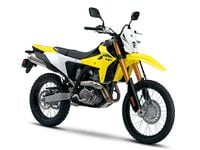
/cloudfront-us-east-1.images.arcpublishing.com/octane/NPAGYYZONRDXFLWK7GPPAPZUKM.jpg)
/cloudfront-us-east-1.images.arcpublishing.com/octane/RBOEDFI6WJBGXP22RLQE4UEUVI.jpg)
/cloudfront-us-east-1.images.arcpublishing.com/octane/G4XNETM6OZE37GNVLWIZJP3FAY.jpg)
/cloudfront-us-east-1.images.arcpublishing.com/octane/JMAWXBQZ4ZDSJBCXDER5SEMWMU.jpg)